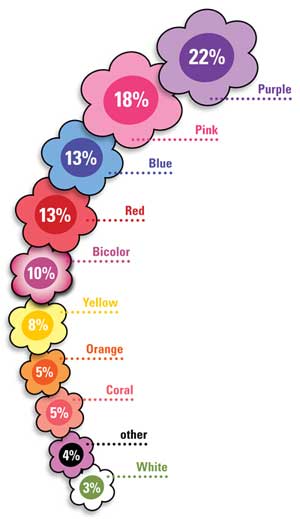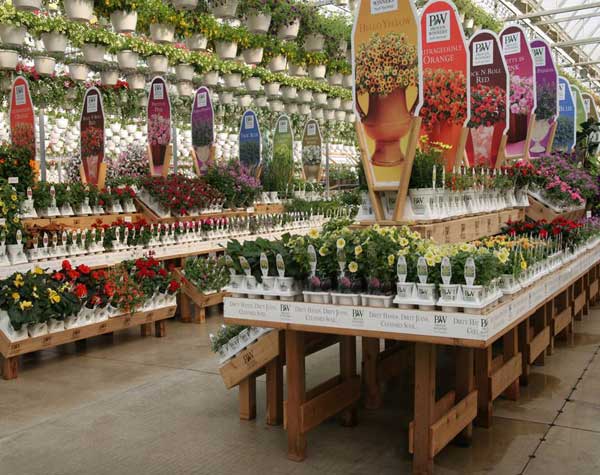Color Trends Heat Up Sales
 Proven Winners® does a consumer poll each year to see which plant colors are most popular. Here are this year’s favorites. |
Use color wisely to inspire customers and boost revenues.
In a highly visual industry like ours, color is everything. Keeping up with color trends can help growers and retailers inspire consumers and in turn, increase profits.
Pantone, considered by many to be the authority on color, names an annual “color of the year,” that drives product development in just about every industry, from fashion to product packaging. This year’s color, “radiant orchid,” is a joyful, purplish-pink, which Leatrice Eiseman, executive director of the Pantone Color Institute, says is a captivating, charming purple that “inspires confidence and emanates great joy, love and health.”
How to Forecast Color Trends
So what influences color trends? While there’s no one driver that determines the “in” colors, one factor does have a tremendous influence: the economy.
Maryann Cole, owner of design firm Marigold Design, serves on the board for the Color Marketing Group, which includes experts from numerous industries across the globe who gather to forecast color trends. “Color trends are driven by what is happening in the economy,” Cole says. In 2008 and 2009, for example, when the U.S. was heading into a recession, yellow was the No. 1 color. “No other color expresses hope and reassurance more than yellow,” Cole explains. “When you think of yellow, you think of sunshine – it’s such a happy color.”
Now that the economy is improving, the popular colors, such as radiant orchid, represent joy, love and hope. “People are combining a lot of different colors right now,” Cole adds.
That holds true in the greenhouse industry, too, according to Proven Winners’ color research. “When the economy is healthy, there’s more tolerance for mixed and wild color combinations,” says Proven Winners® Director of Marketing Marshall Dirks.
Because plants take so long to develop, breeders generally aren’t able to release a new variety the year a color becomes popular, Dirks adds, but Proven Winners has told breeders they’re looking for purple, pink and blue hues. Bicolors are also hot.
When it comes to combination planters, Dirks says consumers are once again leaning toward foliage and flower combinations. But high-contrast combinations like reds with purples are still “risky,” while complementary colors in more muted tones remain popular right now.
 Displays by color, accented by brightly colored P.O.P., make it easy for shoppers to find their favorites. |
Use Color for Retail Sales
For growers and retailers, color is just as important – if not more important – than variety, and a focus on color can help boost sales.
|
“Color is a huge driver in what a gardener purchases,” Dirks says. He adds that garden retailers should always focus on color first, asking customers what their favorite color is before helping them choose plants. “If you just start grabbing sun or shade items but lack the customer’s favorite color, you’re doomed,” he says.
Bridget Behe, Professor of Horticultural Marketing at Michigan State University, says she likes to see color blocks of plants in the garden center. “Big color blocks can have a big visual impact,” she says. “I also like to see some integration of contrasting color and complementary colors with both plants and containers.” Even using colored benches to make plants pop can inspire consumers (think black coleus on a yellow bench).
For someone who’s never tried color blocking, Behe suggests choosing three areas to trial it in. “One of the best measures of success is how fast those benches empty because the plants were sold, and how often new combinations need to be made or restocking needs to be done,” she says.
Behe recommends hanging a color wheel above displays to inspire combinations, too. “If you make ready-made combinations, consider naming them so people know what to ask for next year,” she adds. But keep combinations simple, with no more than about three plants.
Ask the Experts — Your Customers
Most importantly, get customer feedback. Dirks suggests gathering your top customers in the fall for an invitation-only event. Show them 20 new plants that will be available next season. “Allow the comments and feedback from those trusted advisors to impact your purchasing plans for the following year,” he says. You can also allow them to create and name their own combinations. “Getting customers involved with product selection and naming is incredibly powerful,” he says. “Listen to your customer.”
Availability/Ordering | Contact Us | Subscribe to our Newsletter

